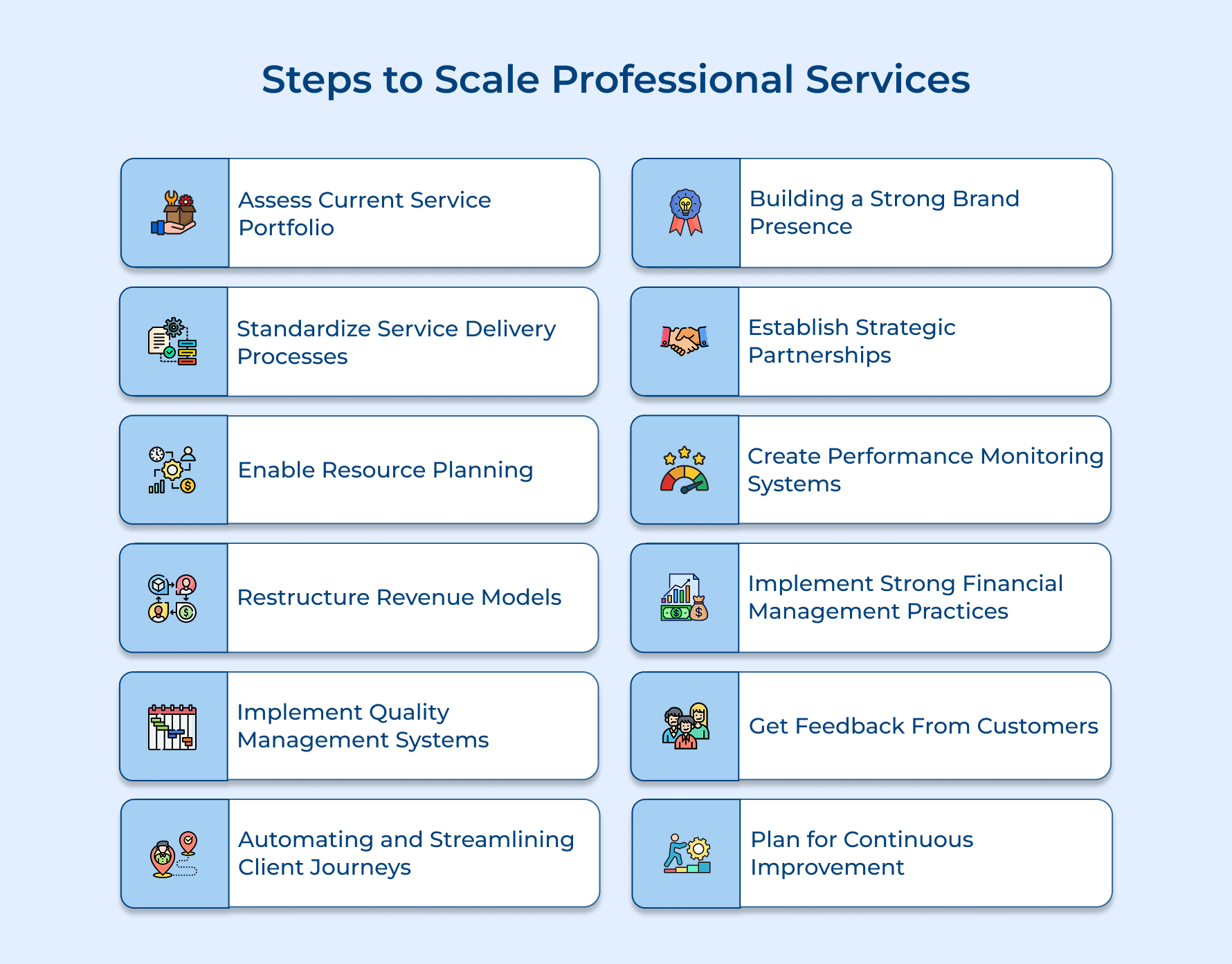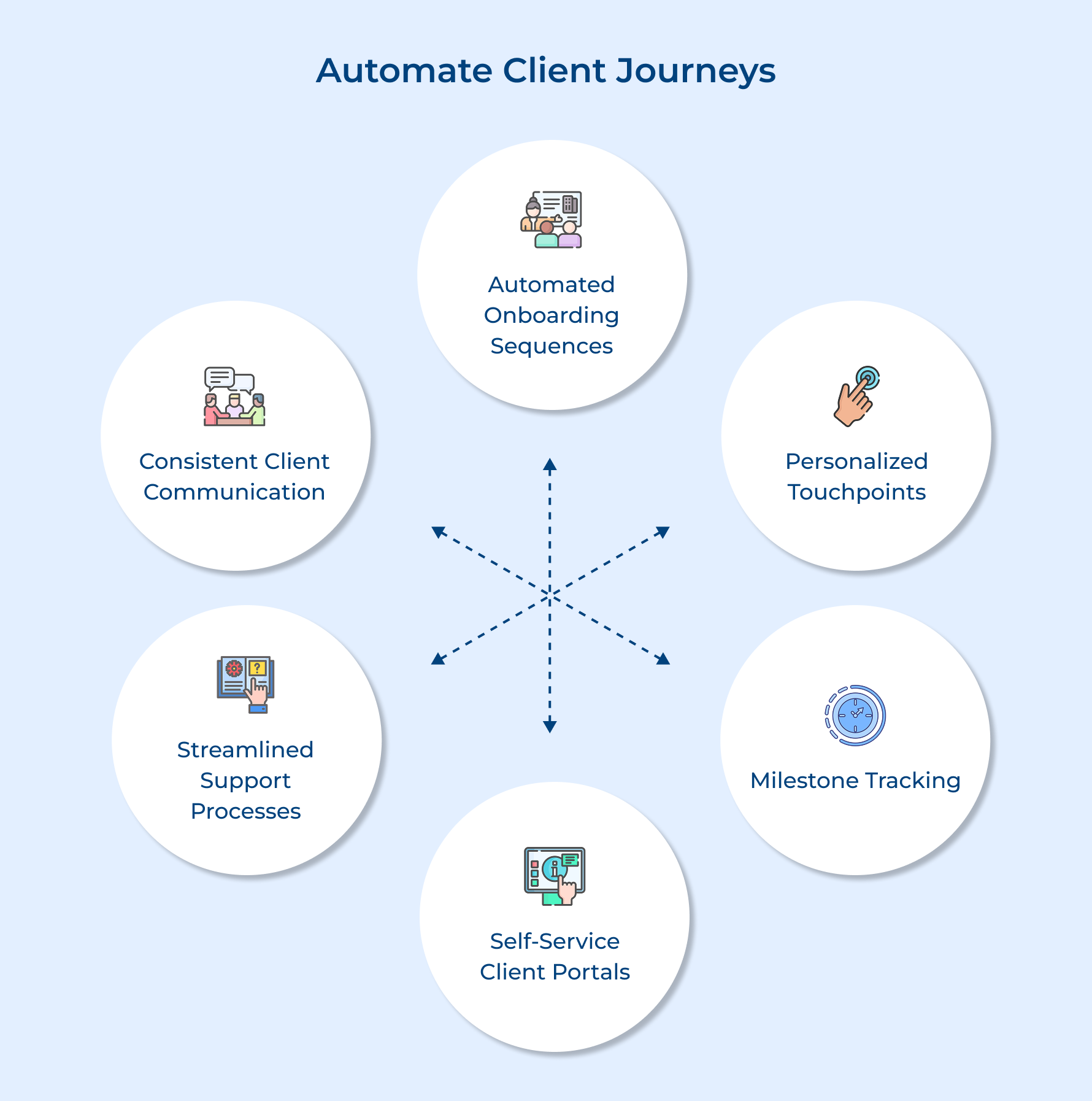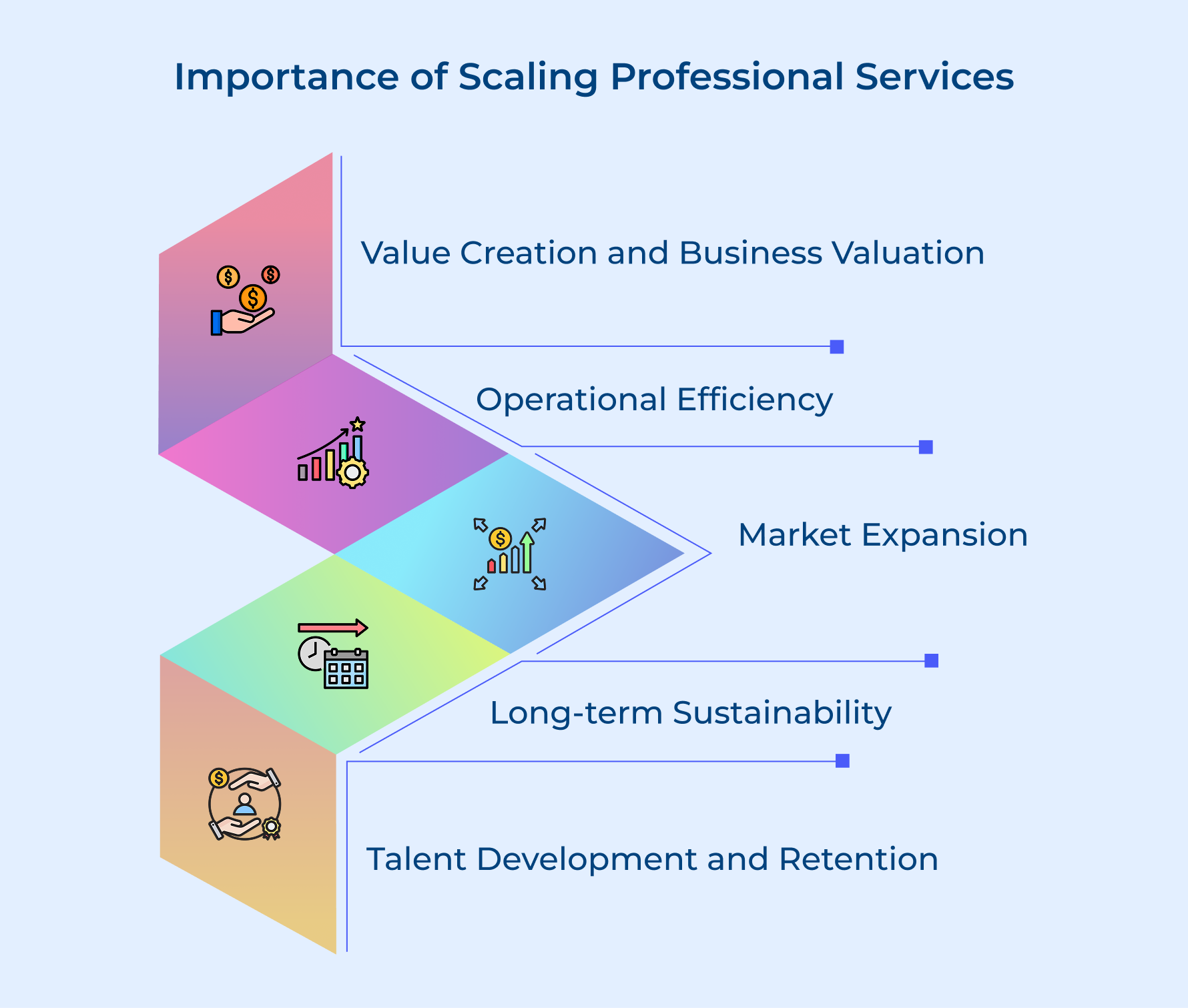How to Scale Professional Services Businesses in 12 Steps

Key Highlights:
- Scaling professional services increases your business’s value and provides better exit options by creating scalable systems.
- Expansion optimizes processes, incorporates technology, and improves service quality, boosting efficiency while enhancing client experiences.
- Growth opens new opportunities by expanding services and markets, reducing reliance on a small client base.
Service-based businesses often struggle with growth due to inconsistent delivery and the time-for-money trap, where revenue is tied to billable hours.
As client demands rise, many firms find themselves overwhelmed, unable to serve more clients or capture new opportunities.
You can overcome stagnation and burnout with the right scalable framework. By standardizing operations, using technology, and creating predictable revenue streams, you can transform your business.
Our guide to how to scale professional services will show you how to break free from traditional constraints and keep your services running smoothly all while staying competitive.
What is Scale Professional Services? Definition
Scaling professional services refers to the strategic process of growing and expanding a service-based business while maintaining or improving service quality, operational efficiency as well as profitability. It involves systematically increasing the organization’s capacity to serve more clients and handle larger projects without proportionally increasing costs or compromising service excellence.
Effective scaling enables organizations to leverage their expertise, methodologies, and resources across a broader client base while creating recurring revenue streams. A well-executed scaling approach helps overcome the inherent limitations of billable hours and allows firms to increase revenue without linearly increasing headcount or operational costs.
Key objectives:
- Standardization of service delivery to ensure consistent quality across all client engagements while reducing operational complexity.
- Development of repeatable methodologies that allow efficient knowledge transfer as well as reduced dependency on individual experts.
- Implementation of technology and automation solutions to streamline operations as well as enhance service delivery capabilities while maintaining personalization.
- Creation of scalable revenue models through productized services, subscription-based offerings, or hybrid delivery approaches that break free from the traditional time-based billing model.
How to Effectively Scale Professional Services?: 12 Strategic Steps
Scaling a professional services firm can feel daunting, but with the right strategies, it’s achievable. Let’s explore 12 proven steps to help your business grow efficiently.
1. Assess Current Service Portfolio and Market Position
Scaling your professional services requires a clear understanding of where you stand and where you want to go. Conducting a thorough market assessment helps you identify growth opportunities and recognize potential challenges.
Evaluate Existing Services
Review your current services to identify what’s working well and what needs improvement.
- Look for strengths you can build on.
- Identify weaknesses or areas where you’re falling short.
Analyze Market Demand
Understand the market’s current needs and potential for growth.
- Research industry trends.
- Identify growing opportunities within your target market.
Assess the Competitive Landscape
Analyze your competitors to see how you measure up.
- Study their service offerings and pricing.
- Identify gaps in the market that you can fill.
Evaluate Organizational Capabilities
Look at your internal resources and processes to determine if they can support scaling.
- Identify areas for improvement.
- Ensure you have the right tools, talent, and infrastructure.
Identify Growth Opportunities and Barriers
Pinpoint areas where you can expand.
- Find opportunities to differentiate from competitors.
- Recognize barriers like resource constraints or market saturation.
Tips to Consider:
- Create a detailed service matrix mapping current offerings against market demand and profitability metrics to identify scaling priorities.
- Conduct quarterly competitor analysis and client feedback sessions to stay aligned with market needs and opportunities.
2. Standardize Service Delivery Processes
To scale your service business effectively, it’s crucial to establish consistent workflows that ensure quality while reducing variability.
Standardizing processes not only makes it easier to replicate success across different clients but also helps maintain service excellence as your operations grow. Here’s how you can build and implement these repeatable methodologies for smoother scaling.
- Create repeatable workflows: Develop consistent, repeatable methods for delivering services to ensure quality and reduce variation. This will help you scale efficiently.
- Reduce dependency on expertise: Standardizing processes minimizes reliance on individual team member’s expertise, ensuring smooth delivery even when scaling up.
- Ensure consistency: With standardized workflows, every client engagement maintains high service quality, no matter how many clients you handle.
- Document best practices: Create process maps, templates, and clear guidelines to make training easier while improving service delivery.
- Implement workflow tools: Use systems to manage workflows and track performance. Continuously improve processes by incorporating feedback.
Actionable Tips:
- Develop comprehensive service delivery playbooks with step-by-step guidelines and quality checkpoints.
- Create a centralized knowledge base of templates, tools, and best practices accessible to all team members.
3. Enable More Sophisticated Resource Planning
As business owners, managing resources efficiently is key to scaling your operations without sacrificing quality. Here’s how you can optimize your resources:
- Plan your resources wisely: Ensure that human capital, technology, and operational assets are used effectively, so there are no bottlenecks in service delivery.
- Balance workload: Prevent resource shortages by managing costs and ensuring your team can handle increased demand.
- Implement resource management tools: Use software to track and allocate resources smartly, adjusting based on demand.
- Monitor utilization rates: Regularly check and adjust how resources are being used to maintain efficiency as well as scalability.
Pro tips:
- Implement a robust resource management system with real-time tracking and forecasting capabilities.
- Develop a flexible talent pool combining full-time staff with trusted contractors for scalability.
4. Restructure Revenue Models
As business owners, adjusting your pricing strategies can significantly boost your profit margins. But, how can you create more predictable and scalable revenue streams?
Move Away from Time-Based Billing:
- Time-based billing can limit your growth potential. Instead, shift to value-based pricing or subscription models for more stable income.
Create Tiered Service Packages:
- Offer different levels of services at varying price points to cater to different client needs while boosting your profit margins.
Implement Subscription Models:
- This provides steady cash flow and reduces revenue volatility.
Productize Your Services:
- Develop packaged offerings that clients can purchase directly, making it easier to scale.
Focus on Value, Not Time:
- Price your services based on the value delivered rather than the hours worked. This increases your profit margins and improves business efficiency.
Measure ROI:
- Establish clear metrics to track return on investment, ensuring your new pricing model delivers the desired results.
Pro tips:
- Create three-tiered service packages with clear value propositions and scalable delivery methods.
- Develop a hybrid pricing model combining retainer-based services with value-based project fees.
5. Implement Quality Management Systems
A structured approach to maintaining and improving service quality is essential for business owners aiming for growth. By using standardized processes, and monitoring systems, along with continuous feedback, you can ensure consistent service delivery across all client projects.
As your business scales, quality management becomes even more crucial to avoid service dips, keep clients happy, and protect your reputation.
Maintain service excellence during growth by establishing clear quality metrics, implementing regular review processes, and setting up feedback loops. Include quality control checks throughout your service delivery and perform audits to ensure your standards are consistently met.
Tips to Consider:
- Implement a multi-level quality review system with clear criteria and accountability measures.
- Develop automated quality monitoring dashboards with real-time alerts for potential issues.
6. Automating and Streamlining Client Journeys
Streamlining client journeys is a strategic implementation of technology and processes to enhance client experience while reducing manual effort. It includes automating routine tasks, communications, and service delivery components.
Automation enables handling increased client volume without proportional resource increase. It improves efficiency, reduces errors, ensures consistent communication, and enhances client experience while supporting scale.
Deploy CRM systems, implement automated workflows, as well as create self-service portals. Use technology to streamline onboarding, delivery, and support processes while maintaining personalized service elements.
Pro tips:
- Create automated client onboarding sequences with personalized touchpoints and clear milestone tracking.
- Implement a client portal for self-service access to common requests and project updates.
7. Building a Strong Brand Presence
Building a strong brand is essential for service-based businesses looking to scale. It establishes your expertise, builds trust with clients, and creates a foundation for growth. Let’s explore how a strategic brand presence can make all the difference,
Strategic Brand Development:
Build and maintain a distinctive market presence that highlights your expertise, reliability, as well as value. Consistent messaging across all channels helps reinforce this image.
Benefits of a Strong Brand:
- Reduces client acquisition costs.
- Supports premium pricing.
- Builds market trust and attracts ideal clients.
- Establishes market leadership, paving the way for scaling.
Steps to Strengthen Your Brand:
- Create clear brand guidelines for consistency.
- Produce valuable content that resonates with your audience.
- Maintain consistent messaging across all channels.
- Use thought leadership and client success stories to reinforce your market position
Actionable Tips:
- Create a comprehensive content calendar focusing on industry expertise and client success stories.
- Develop a brand ambassador program within your organization to amplify brand presence.
8. Establish Strategic Partnerships
Forming strong partnerships with complimentary service providers, technology vendors, and industry players can significantly enhance your service capabilities as well as expand your market reach. These partnerships allow you to tap into new resources and expertise without making heavy internal investments.
To make the most of these partnerships, it’s important to identify potential partners who align with your business goals. Developing a collaboration framework and creating joint service offerings can strengthen the partnership.
Establishing clear agreements while maintaining open communication channels is key to ensuring the partnership runs smoothly and remains mutually beneficial.
Pro tips:
- Create a partner evaluation matrix with clear criteria for potential partnership assessment.
- Develop quarterly partnership review processes to measure impact and optimize relationships.
9. Create Performance Monitoring Systems
Monitoring key performance indicators (KPIs) is essential for effective scaling. It helps track progress, identify improvement areas, and make data-driven decisions for sustainable growth.
- Track and measure key performance indicators (KPIs): Set up a system to monitor KPIs across service delivery, client satisfaction, financial performance, and operational efficiency.
- Ensure growth is on track: Regular performance monitoring helps you stay on top of scaling efforts and quickly identifies areas that need attention.
- Make data-driven decisions: Use the insights from KPIs to make informed decisions and maintain control as your business grows.
- Set up dashboards: Implement dashboards to easily track your key metrics in real time.
- Establish regular reviews: Have review cycles in place to analyze performance regularly.
- Create action plans: Use data insights to develop action plans and address issues proactively.
- Automated alerts: Set up automated alerts to notify you of any performance deviations.
- Conduct performance reviews: Regularly assess your performance to ensure everything stays on course and adjust strategies as needed.
Tips to consider:
- Develop a balanced scorecard with metrics covering financial, operational, client, and team performance aspects.
- Create weekly performance review routines with clear accountability and action item tracking.
10. Implement Strong Financial Management Practices
Scaling a business successfully requires strong financial management to ensure profitability and sustainability. Here’s how to do it more efficiently,
- Effective financial management is key to sustainable scaling. It helps businesses track cash flow, profitability, and resource utilization as they grow.
- Maintain healthy cash flow by setting clear budgets, forecasts, and financial control measures.
- Identify financial risks early to ensure growth doesn’t come at the expense of profitability.
- Use financial planning tools to track progress, develop detailed budgets, and forecast future needs.
- Monitor key financial metrics regularly and adjust strategies based on performance to keep growth on track.
Actionable Tips:
- Create rolling 12-month cash flow forecasts updated monthly with actual performance data.
- Implement project-level profitability tracking with monthly variance analysis.
11. Get Feedback From Customers
Gathering and acting on client feedback is key to maintaining quality while scaling. It ensures services meet client needs and helps refine strategies for sustained growth.
- Set up formal and informal channels to collect client feedback. Use surveys, review meetings, along with ongoing check-ins.
- Regularly analyze feedback to identify areas for improvement. Pinpoint service issues, value gaps, and growth opportunities.
- Implement changes based on insights to align services with client expectations. Continuously refine processes as well as adjust service delivery.
- Use client feedback to identify new opportunities and enhance client satisfaction. Ensure scaling efforts stay aligned with client needs.
Pro tips:
- Establish quarterly client satisfaction surveys with specific questions about service quality and value.
- Create a client advisory board meeting bi-annually to gather strategic feedback.
12. Plan for Continuous Improvement
A structured approach to regularly evaluating while also enhancing all aspects of service delivery, operations, and client experience based on performance data as well as feedback.
Continuous improvement ensures scaling efforts evolve with changing market needs and maintain competitiveness. It helps identify and address inefficiencies while promoting innovation.
Implement regular review cycles, encourage team innovation, and create improvement action plans. Monitor industry trends and best practices to identify enhancement opportunities.
Pro tips:
- Schedule monthly team innovation sessions to identify and evaluate improvement opportunities.
- Create a systematic process for testing and implementing improvement initiatives with clear success metrics.
Why is Scaling Professional Services Business Important?
Scaling your professional services business is key to staying competitive and growing over time. Here are other factors why it’s important.
Value Creation and Business Valuation
When you scale your professional services business, you increase its value. Scalable systems, repeatable processes, and consistent revenue streams make your business more attractive to investors as well as provide better exit options.
Operational Efficiency
Expansion helps streamline processes, incorporate technology, and improve efficiency. These enhancements reduce costs, boost service quality, and create better client experiences, all while supporting sustainable growth.
Market Expansion
Scaling opens up new opportunities, whether by expanding geographically or diversifying services. Reaching a wider audience reduces reliance on a small customer base as well as opens the door to fresh growth possibilities.
Long-term Sustainability
Growing your business sets it up for long-term success. With the ability to invest in growth as well as adapt to market changes, a scaled business has a strong competitive edge and is well-positioned for the future.
Talent Development and Retention
As your business grows, it creates more opportunities for career advancement, helping to retain top talent. A larger organization offers diverse learning experiences, clear career paths, and better development programs for your team.
Maximizing Profitability Through Smart Scaling Practices
Scaling professional services successfully requires a strategic blend of standardization, technology adoption, and unwavering commitment to service excellence. Organizations that master this balance can achieve sustainable growth while maintaining their core value proposition.
Remember, effective scaling is an ongoing process rather than a destination. Focus on building robust foundations through standardized processes, leveraging technology, and maintaining strong client relationships. Keep monitoring performance metrics, gathering feedback, and adapting strategies as needed. The journey to scale professional services isn’t just about growing bigger – it’s about growing smarter.
Limit time — not creativity
Everything you need for customer support, marketing & sales.
Neeti Singh is a passionate content writer at Kooper, where he transforms complex concepts into clear, engaging and actionable content. With a keen eye for detail and a love for technology, Tushar Joshi crafts blog posts, guides and articles that help readers navigate the fast-evolving world of software solutions.


